Medium format aside, we all know full frame mirrorless cameras purport to offer the best marriage of image quality yet portability. With the ability to crop images if desired, play with shallow depth of field, still maintain shedloads of detail, plus avoid intrusive image noise thanks to a surface area not overburdened with pixels. But while pausing to weigh up whether I can afford to buy one in straitened times – yes, Sony’s A1 II and A9 III are, indeed, impressive – I find myself pontificating instead on whether I honestly need a full frame camera. Despite the stated benefits.
I am not convinced I do. Yes, I would be getting a sensor size akin to a frame of 35mm film at 24x36mm, thereby also raising the possibility of utilising vintage analogue-era glass.
But that was then, and this is now. Wasn’t digital photography about shaking off such shackles and trying something different, rather than tethering ourselves to the traditional? A sort of technological year zero?
In truth, as an amateur photographer primarily, a full frame camera is very much a ‘nice to have’ for me at this stage, rather than a life or career essential. I’ve used everything from 1/2.3-inch sensor pocket point and shoot compacts, up to medium format behemoths, and though the difference in quality from the former to the latter is immediately noticeable, it’s less so when comparing a Micro Four Thirds, APS-C and full frame sensor incorporating camera. Especially if I’m just viewing the resulting images on screen and aren’t even considering making an 8×10-inch print, let alone blowing shots up to billboard size.
Hell, in those circumstances most smartphone snaps can prove sufficient.
It’s not just the full frame camera itself I need justify either, but the added expense of a lens of sufficient quality to be able to do justice to the sensor and prove capable of resolving that level of detail. Such optics predictably don’t come cheap and a standard kit zoom isn’t going to cut it. There’s no point in spending big on a camera and then compromising on lens quality to the possible detriment of the image.
Then there’s the added bulk and weight typically associated with a full frame camera when compared to a consumer level mirrorless camera with a smaller sensor. For me a flagship model doesn’t always feel comfortable or practical, and perhaps we don’t need the high degree of dust and weather sealing associated with a more pro-end full frame camera either. Most of us are fair weather photographers, after all. Or it’s when we head off on holiday that we think of packing the ‘proper’ camera.
Put simply, though something we’re encouraged to aspire to and the accepted gold standard for pros, for most of us full frame cameras aren’t actually worth the expense.
I am not alone, being controversial for the sake of it, or going out on a limb in thinking this. While Canon, Nikon, Sony, Panasonic, Sigma and Leica flagship cameras are all full frame, elsewhere we find pockets of resistance.
Fujifilm has long maintained use of the APS-C format for its Fujifilm X series cameras and ditto OM System/Olympus with Micro Four Thirds. As much a commercial decision for those two as a creative one, undoubtedly. Yet both still offer considerable bang for our buck when compared to competitors’ full frame incorporating leviathans. And since I don’t feel short changed or like I’m getting second best when using cameras from either, it can be argued that I’m getting a better marriage of image quality and portability over full frame after all.
Related reading
- Forget megapixels: The one spec that actually matters in a camera
- APS-C vs full-frame – which sensor size is best, and why it matters
The views expressed in this column are not necessarily those of Amateur Photographer magazine or Kelsey Media Limited. If you have an opinion you’d like to share on this topic, or any other photography related subject, email: ap.ed@kelsey.co.uk








